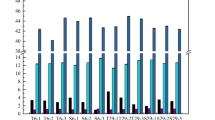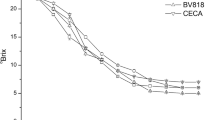Abstract
The effect of different yeast strains on the quality of kiwi wine was investigated by polyphase determine approaches in the present research. The influence of co-culture and inoculation sequence on the quality was also explored simultaneously. Results suggested that the characteristics of the kiwi wine were affected by the metabolic characteristic of strains. The flavor content and their flavor profile of samples fermented by co-culturing of strain among species, genus, and families. When Saccharomyces bayanus (Y5 or Y6) co-cultured with Torulaspora delbrueckii Y7, the ratio of phenethyl alcohol increased, but that of octanoic acid and ethyl octanoate decreased significantly. The odor activity value (OAV) of ethyl octanoate and ethyl hexanoate was increased by co-culturing Saccharomyces with T. delbrueckii, and that of decanal and terpinen-4-ol was enhanced by co-culturing of different strains of Saccharomyces. It was an excepting process to obtain high quality of kiwi wine by co-culturing technology of yeasts, and was very effective to optimize the process by polyphase analysis approaches.








Similar content being viewed by others
References
Giudici P, Zambonelli C, Passarelli P, Castellari L (1995) Improvement of wine composition with cryotolerant Saccharomyces strains. Am J Enol Viticult 46:143–147
Castellari L, Pacchioli G, Zambonelli C, Tini V, Grazia I (1992) Isolation and initial characterization of cryotolerant Saccharomyces strains. Ital J Food Sci 3:179–186
Muratore G, Asmundo CN, Lanza CM, Caggia C, Licciardello F, Restuccia C (2007) Influence of Saccharomyces uvarum on volatile acidity, aromatic and sensory profile of Malvasia delle Lipari wine. Food Technol Biotech 45:101–106
Eglinton JM, Mcwilliam SJ, Fogarty MW, Francis IL, Kwiatkowski MJ, HØJ PB, Henschke PA (2000) The effect of Saccharomyces bayanus-mediated fermentation on the chemical composition and aroma profile of Chardonnay wine. Aust J Grape Wine R 6:190–196
Loira I, Vejarano R, Bañuelos MA, Morata A, Tesfaye W, Uthurry C, Villa A, Cintora I, Suárez-Lepe JA (2014) Influence of sequential fermentation with Torulaspora delbrueckii and Saccharomyces cerevisiae on wine quality. LWT-Food Sci Technol 59:915–922
Sanoppa K, Huang T-C, Wu M-C (2019) Effects of Saccharomyces cerevisiae in association with Torulaspora delbrueckii on the aroma and amino acids in longan wines. Food Sci Nutr 7:2817–2826
Chen D, Liu SQ (2016) Impact of simultaneous and sequential fermentation with Torulaspora delbrueckii and Saccharomyces cerevisiae on non-volatiles and volatiles of lychee wines. LWT-Food Sci Technol 65:53–61
Sun SY, Gong HS, Zhao YP, Liu WL, Jin CW (2016) Sequential culture with Torulaspora delbrueckii and Saccharomyces cerevisiae and management of fermentation temperature to improve cherry wine quality. J Sci Food Agr 96:1880–1887
Benito S (2018) The impact of Torulaspora delbrueckii yeast in winemaking. Appl Microbiol Biotechnol 102:3081–3094
Visintina S, Ramob L, Batista N, Dolci P, Schwan F, Cocolin L (2017) Impact of Saccharomyces cerevisiae and Torulaspora delbrueckii starter cultures on cocoa beans fermentation. Int J Food Microbiol 257:31–40
Liu S, Laaksonen O, Kortesniemi M, Kalpio M, Yang B (2018) Chemical composition of bilberry wine fermented with non-Saccharomyces yeasts (Torulaspora delbrueckii and Schizosaccharomyces pombe) and Saccharomyces cerevisiae in pure, sequential and mixed fermentations. Food Chem 266:262–274
Sadineni V, Kondapalli N, Obulam VSR (2012) Effect of co-fermentation with Saccharomyces cerevisiae and Torulaspora delbrueckii or Metschnikowia pulcherrima on the aroma and sensory properties of mango wine. Ann Microbiol 62:1353–1360
Lu Y, Chua J-Y, Huang D, Lee P-R, Liu S-Q (2016) Biotransformation of chemical constituents of durian wine with simultaneous alcoholic fermentation by Torulaspora delbrueckii and malolactic fermentation by Oenococcus oeni. Appl Microbiol Biotechnol 100:8877–8888
Garcia CV, Quek S-Y, Stevenson RJ, Winz RA (2012) Kiwifruit flavour: A review. Trends Food Sci Tech 24:82–91
López-Vázquez C, García-Llobodanin L, Pérez-Correa JR, López F, Blanco P, Orriols I (2012) Aromatic characterization of pot distilled kiwi spirits. J Agr Food Chem 60:2242–2247
Xi H (1999) China fruit wine. China light industry, Beijing
Li X, Xing Y, Cao L, Xu Q, Li S, Wang R, Jiang Z, Che Z, Lin H (2017) Effects of six commercial Saccharomyces cerevisiae strains on phenolic attributes, antioxidant activity, and aroma of kiwi (Actinidia deliciosa, cv.) wine. Biomed Res Int 2017:1–10
Soufleros EH, Pissa I, Petridis D, Lygerakis M, Mermelas K, Boukouvalas G, Tsimitakis E (2001) Instrumental analysis of volatile and other compounds of Greek kiwi wine; sensory evaluation and optimisation of its composition. Food Chem 75:487–500
SAC (2006) Analytical methods of wine and fruit wine. Standardization administration of the People's Republic of China, Beijing
Bimpilas A, Panagopoulou M, Tsimogiannis D, Oreopoulou V (2016) Anthocyanin copigmentation and color of wine: The effect of naturally obtained hydroxycinnamic acids as cofactors. Food Chem 197:39–46
Wang X, Xie K, Zhuang H, Ye R, Fang Z, Feng T (2015) Volatile flavor compounds, total polyphenolic contents and antioxidant activities of a China gingko wine. Food Chem 182:41–46
Liang R, Huang J, Wu X, Xu Y, Fan J, Wu C, Jin Y, Zhou R (2019) Characterizing the metabolites and the microbial communities of the soy sauce mash affected by temperature and hydrostatic pressure. Food Res Int 123:801–808
Niu M, Huang J, Jin Y, Wu C, Zhou R (2017) Volatiles and antioxidant activity of fermented Goji (Lycium Chinese) wine: effect of different oak matrix (barrel, shavings and chips). Int J Food Prop 20:S2057–S2069
Canonico L, Solomon M, Comitini F, Ciani M, Varela C (2019) Volatile profile of reduced alcohol wines fermented with selected non-Saccharomyces yeasts under different aeration conditions. Food Microbiol 84:103247
Hayasaka Y, Birse M, Eglinton J, Herderich M (2007) The effect of Saccharomyces cerevisiae and Saccharomyces bayanus yeast on colour properties and pigment profiles of a Cabernet Sauvignon red wine. Aust J Grape Wine R 13:176–185
Magyar I, Tóth T (2011) Comparative evaluation of some oenological properties in wine strains of Candida stellata, Candida zemplinina, Saccharomyces uvarum and Saccharomyces cerevisiae. Food Microbiol 28:94–100
Caridi A (2007) New perspectives in safety and quality enhancement of wine through selection of yeasts based on the parietal adsorption activity. Int J Food Microbio 120:167–172
Dobrowolska-Iwanek J, Gąstol M, Wanat A, Krośniak M, Jancik M, Zagrodzki P (2014) Wine of cool-climate areas in south Poland. S Afr J Enol Vitic 35:1–9
Zhong W, Li X, Yang H, Li E (2019) A novel, effective, and feasible method for deacidifying kiwifruit wine by weakly basic ion exchange resins. J Food Process Eng 42:e12969
Sun SY, Che CY, Sun TF, Lv ZZ, He SX, Gu HN, Shen WJ, Chi DC, Gao Y (2013) Evaluation of sequential inoculation of Saccharomyces cerevisiae and Oenococcus oeni strains on the chemical and aromatic profiles of cherry wines. Food Chem 138:2233–2241
Duarte WF, Dias DR, Oliveira JM, Vilanova M, Teixeira JA, Silva JB, Schwan RF (2010) Raspberry (Rubus idaeus L.) wine: Yeast selection, sensory evaluation and instrumental analysis of volatile and other compounds. Food Res Int 43:2303–2314
Sadoudi M, Tourdot-Maréchal R, Rousseaux S, Steyer D, Gallardo-Chacón J-J, Ballester J, Vichi S, Guérin-Schneider R, Caixach J, Alexandre H (2012) Yeast-yeast interactions revealed by aromatic profile analysis of Sauvignon Blanc wine fermented by single or co-culture of non-Saccharomyces and Saccharomyces yeasts. Food Microbiol 32:243–253
Andorrà I, Berradre M, Rozès N, Mas A, Guillamón JM, Esteve-Zarzoso B (2010) Effect of pure and mixed cultures of the main wine yeast species on grape must fermentations. Eur Food Res Technol 231:215–224
Benito S, Hofmann T, Laier M, Lochbühler B, Schüttler A, Ebert K, Fritsch S, Röcker J, Rauhut D (2015) Effect on quality and composition of Riesling wines fermented by sequential inoculation with non-Saccharomyces and Saccharomyces cerevisiae. Eur Food Res Technol 241:707–717
Azzolini M, Tosi E, Lorenzini M, Finato F, Zapparoli G (2015) Contribution to the aroma of white wines by controlled Torulaspora delbrueckii cultures in association with Saccharomyces cerevisiae. World J Microb Biot 31:277–293
Viana F, Gil JV, Genovés S, Valles S, Manzanares P (2008) Rational selection of non-Saccharomyces wine yeasts for mixed starters based on ester formation and enological traits. Food Microbiol 25:778–785
Acknowledgements
This research was financially supported by the Sichuan University–Luzhoulaojiao Company Fund (Grant No. 17H1039).
Author information
Authors and Affiliations
Corresponding author
Ethics declarations
Conflict of interest
The authors declare that they have no conflict of interests.
Compliance with ethics requirements
This article does not contain any studies with human or animal subjects.
Additional information
Publisher's Note
Springer Nature remains neutral with regard to jurisdictional claims in published maps and institutional affiliations.
Electronic supplementary material
Below is the link to the electronic supplementary material.
Rights and permissions
About this article
Cite this article
Liu, J., Liu, M., Ye, P. et al. Characterization of major properties and aroma profile of kiwi wine co-cultured by Saccharomyces yeast (S. cerevisiae, S. bayanus, S. uvarum) and T. delbrueckii. Eur Food Res Technol 246, 807–820 (2020). https://doi.org/10.1007/s00217-020-03439-6
Received:
Revised:
Accepted:
Published:
Issue Date:
DOI: https://doi.org/10.1007/s00217-020-03439-6




